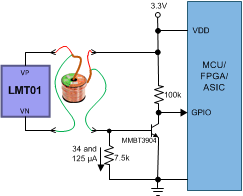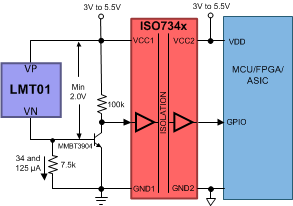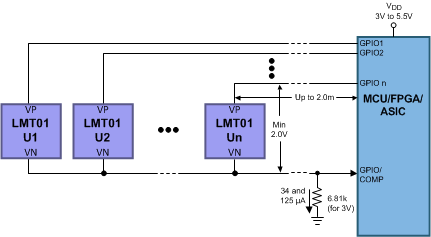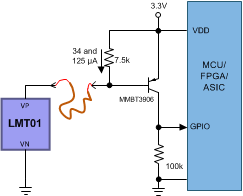SNIS192C November 2016 – June 2018 LMT01-Q1
PRODUCTION DATA.
- 1 Features
- 2 Applications
- 3 Description
- 4 Revision History
- 5 Pin Configuration and Functions
-
6 Specifications
- 6.1 Absolute Maximum Ratings
- 6.2 ESD Ratings
- 6.3 Recommended Operating Conditions
- 6.4 Thermal Information
- 6.5 Electrical Characteristics
- 6.6 Electrical Characteristics - TO-92/LPG Pulse Count to Temperature LUT
- 6.7 Electrical Characteristics - WSON/DQX Pulse Count to Temperature LUT
- 6.8 Switching Characteristics
- 6.9 Timing Diagram
- 6.10 Typical Characteristics
- 7 Detailed Description
- 8 Application and Implementation
- 9 Power Supply Recommendations
- 10Layout
- 11Device and Documentation Support
- 12Mechanical, Packaging, and Orderable Information
Package Options
Mechanical Data (Package|Pins)
Thermal pad, mechanical data (Package|Pins)
- DQX|2
Orderable Information
8.3 System Examples
The LMT01 device can be configured in a number of ways. Transistor level shifting can be used so that the output pulse of the device can be read with a GPIO (see Figure 26). An isolation block can be inserted to achieve electrical isolation (see Figure 27). Multiple LMT01 devices can be controlled with GPIOs enabling temperature monitor for multiple zones. Lastly, the LMT01 device can be configured to have a common ground with a high side signal (see Figure 29).
 Figure 26. Transistor Level Shifting
Figure 26. Transistor Level Shifting
 Figure 27. Isolation
Figure 27. Isolation

Note: to turn off an LMT01-Q1 set the GPIO pin connected to VP to high impedance state as setting it low would cause the off LMT01-Q1 to be reverse biased. Comparator input of MCU must be used.
Figure 28. Connecting Multiple Devices to One MCU Input Pin

Note: the VN of the LMT01-Q1 must be connected to the MCU GND.
Figure 29. Common Ground With High-Side Signal